Punic Wars › The Meaning of European Upper Paleolithic Rock Art » Origins and History
Articles and Definitions › Contents
- Punic Wars › Ancient History
- The Meaning of European Upper Paleolithic Rock Art › Antique Origins
Ancient civilizations › Historical places, and their characters
Punic Wars › Ancient History
Definition and Origins
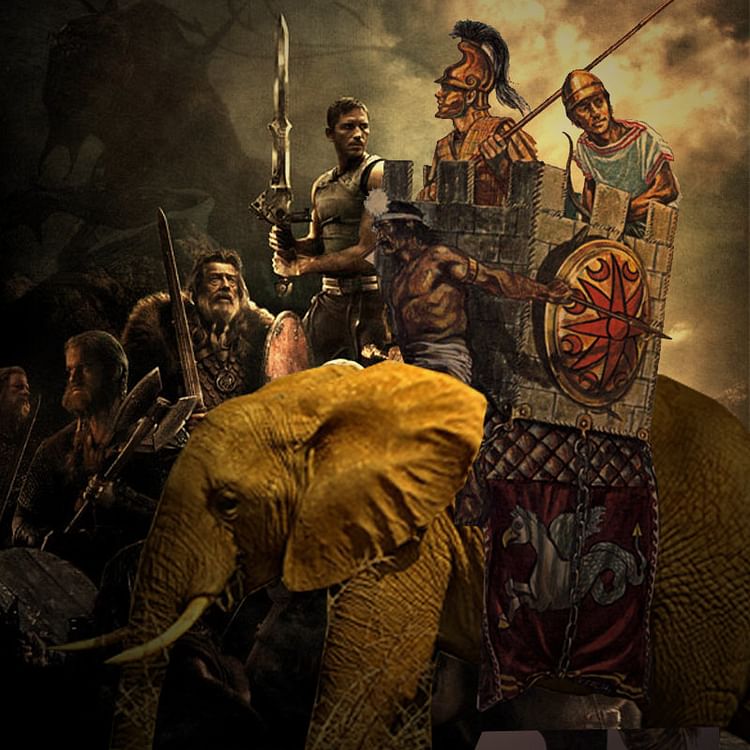
The Punic Wars were a series of conflicts fought between the forces of ancient Carthage and Rome between 264 BCE and 146 BCE. The name Punic comes from the word Phoenician ( Phoinix in the Greek, Poenus from Punicus in Latin) as applied to the citizens of Carthage, who were of Phoenician ethnicity. As the history of the conflict was written by Roman authors, they labeled it 'The Punic Wars'. Carthage grew from a small port-of-call to the richest and most powerful city in the Mediterranean region before 260 BCE. She had a powerful navy, a mercenary army and, through tribute, tariffs, and trade, enough wealth to do as she pleased. Through a treaty with the small city of Rome, she barred Roman trade in the Western Mediterranean and, as Rome had no navy, was able to easily enforce the treaty. Roman traders caught in Carthaginian waters were drowned and their ships taken.
FIRST PUNIC WAR
As long as Rome remained the little city of trade by the Tiber River, Carthage reigned supreme; but the island of Sicily would be the flashpoint for growing Roman resentment of the Carthaginians. Sicily lay partly under Carthaginian and partly under Roman control. When Heiro II of neighboring Syracuse fought against the Mamertines of Messina, the Mamertines asked first Carthage and then Rome for help. The Carthaginians had already agreed to help and felt betrayed by the Mamertines' appeal to Rome. They changed sides, sending forces to Hiero II. The Romans fought for the Mamertines of Messina and, in 264 BCE, Rome and Carthage declared war on each other for the control of Sicily.
HAMILCAR BARCA STRUCK WITHOUT WARNING UP & DOWN THE COAST OF ITALY DESTROYING ROMAN OUTPOSTS & CUTTING SUPPLY LINES.
Although Rome had no navy and knew nothing of sea battles, they swiftly built and equipped 330 ships. As they were far more used to fighting land battles, they devised the clever device of the corvus, a moveable gangplank, which could be attached to an enemy's ship and held in place with hooks. By immobilizing the other ship, and attaching it to their own, the Romans could manipulate a sea engagement through the strategies of a land battle. Even so, they lacked the expertise at sea of the Carthaginians and, more importantly, were lacking a general with the skill of the Carthaginian Hamilcar Barca. Hamilcar was surnamed Barca (meaning `lightning') because of his speed in attacking anywhere and the suddenness of the action. He struck without warning up and down the coast of Italy destroying Roman outposts and cutting supply lines.
Had the Carthaginian government better supplied and reinforced Hamilcar, they most probably would have won the war but, instead, they contented themselves with hoarding their wealth and trusted to Hamilcar and his mercenaries to take care of the war. He defeated the Romans at Drepana in 249 BCE but then was forced to withdraw due to a lack of manpower and supplies. According to the historian Durant,
Worn out almost equally, the two nations rested for nine years. But while in those years Carthage did nothing…a number of Roman citizens voluntarily presented to the state a fleet of 200 men-of-war, carrying 60,000 troops.
The Romans, more experienced at sea battles now and better equipped and led, won a series of decisive victories over Carthage and in 241 BCE the Carthaginians sued for peace.
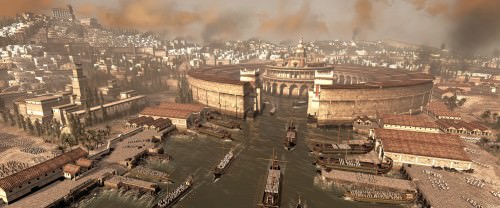
Carthage and its Harbour
This war was costly to both sides but Carthage suffered more seriously owing to the corruption and incompetence of her government (which embezzled funds which should have gone to the military and consistently refused to send much needed supplies and reinforcements to generals in the field), the mostly mercenary army (who often simply refused to fight), and an over-reliance on the brilliance of Hamilcar Barca. Further, however, they seriously underestimated their enemy. While Carthage would largely ignore the war, leaving the fighting to Hamilcar and his mercenaries, Rome would be building and equipping more ships and training more men. Even though Rome had never had a navy before the First Punic War, they emerged in 241 BCE as masters of the sea and Carthage was a defeated city.
CARTHAGE CONCENTRATED ON THE CONQUEST OF SPAIN RATHER THAN TRYING TO DRIVE THE ROMANS OUT OF THEIR FORMER COLONIES.
During the war, the Carthaginian government had repeatedly failed to pay its mercenary army and, also in 241 BCE, these mercenaries laid siege to the city. Hamilcar Barca was called upon to raise the siege and did so, even though Carthage had refused him the much-needed supplies and reinforcements on his campaigns on her behalf and he had led most of these mercenaries in battle himself. The Mercenary War lasted from 241-237 BCE and, while Carthage was engaged in this conflict, Rome occupied the Carthaginian colonies of Sardinia and Corsica. While Carthage was unhappy with this development, there was little they could do about it. They concentrated their efforts on the conquest of Spain rather than trying to drive the Romans out of their former colonies.
In 226 BCE the Ebro Treaty was signed between Carthage and Rome agreeing that the Romans would hold Spanish territory north of the Ebro River, Carthage would hold the area they had already conquered south of the river, and neither nation would cross the boundary.
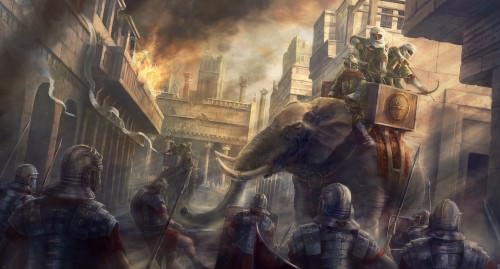 CARTHAGINIAN WAR ELEPHANT
CARTHAGINIAN WAR ELEPHANT

SECOND PUNIC WAR
To the south of the border lay the city of Saguntum, a Roman ally, and, in 219 BCE, the great Carthaginian general Hannibal(Hamilcar's son) lay siege to the city and took it. The Romans objected to this attack and demanded that Carthage deliver Hannibal to Rome. The Carthaginian senate refused to comply and so began the Second Punic War (218-202 BCE).
HANNIBAL WAS CAUGHT IN SOUTHERN ITALY IN A CAT & MOUSE GAME WITH THE ROMAN ARMY.
Hannibal, a sworn enemy of Rome, received intelligence that Roman armies were moving against him and, in a bold gamble, marched his forces over the Alps and into northern Italy. Hannibal then proceeded to win every single engagement against the Romans, conquering northern Italy and gathering former allies of Rome to his side. Having lost many of his elephants on his march over the mountains, and lacking necessary siege engines and troops, Hannibal was caught in southern Italy in a cat and mouse game with the Roman army under Quintus Fabius Maximus. Fabius refused to engage Hannibal directly relying, instead, on cutting off his supplies and starving his army.
Fabius' strategy might have worked had not the Romans become impatient with their legions' inactivity. Further, Hannibal used counter-intelligence to reinforce and spread the rumor that Fabius refused to fight because he was in the pay of the Carthaginians. Fabius was replaced by Caius Terentius Varro and Lucius Aemilius Paulus who threw off caution and led their troops against Hannibal in the region of Apulia. At the Battle of Cannae in 216 BCE, Hannibal placed his Gauls in the center of his lines, expecting they would give way before the Roman forces. When they did exactly that, and the Romans pressed what they saw as an advantage and followed them, Hannibal closed from behind and the sides, enveloping the Roman forces and crushing them. 44,000 Roman soldiers died at Cannae compared with 6000 of Hannibal's forces. Hannibal won his greatest victory but could not build upon it as Carthage refused to send him the reinforcements and supplies he needed.

Campaigns of the Second Punic War
Shortly after this, the Roman general, Publius Cornelius Scipio (later known as Scipio Africanus, who had fought against Hannibal at Cannae) was defeating the Carthaginian forces in Spain (under Hannibal's brother, Hasdrubal). Recognizing that Hannibal's army would be recalled if Carthage were attacked, Scipio manned a fleet and sailed to North Africa where he took the Carthaginian city of Utica. Carthage recalled Hannibal from Italy to save their city but Scipio was a great admirer of Hannibal and had studied his tactics carefully. At the Battle of Zama in 202, Hannibal sent an elephant charge against the Romans which Scipio, mindful of Hannibal's strategies, deflected easily. The Romans killed the Carthaginians on the elephants and sent the animals back into the Carthaginian ranks, then followed with a combined cavalry charge and infantry advance which caught the enemy between and crushed them. Hannibal returned to the city and told the Senate that Carthage should immediately surrender.

Scipio Africanus the Elder
Scipio allowed Carthage to retain her colonies in Africa but she had to surrender her navy and was not allowed to make war under any circumstances without Rome's approval. Carthage was also to pay Rome a war debt of 200 talents every year for fifty years. Carthage was, again, a defeated city but, retaining its trading ships and ten warships to protect them, was able to struggle on and begin to prosper. The Carthaginian government, however, still as corrupt and selfish as it had always been, taxed the people heavily to help pay the war debt while they, themselves, contributed nothing. Hannibal came out of retirement to try to rectify the situation, was betrayed by the rich Carthaginians to the Romans, and fled. He died by his own hand, drinking poison, in 184, aged sixty-seven.
THIRD PUNIC WAR : CARTHAGE DESTROYED
Carthage continued paying the war debt to Rome for the proscribed fifty years and, when it was done, considered their treaty with Rome completed also. They went to war against Numidia, were defeated, and had to then pay that nation another war debt. As they had gone to war without Rome's approval, the Roman senate considered Carthage a threat to the peace again.
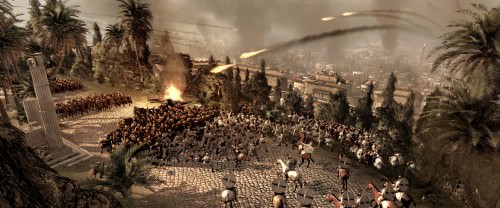
Carthage Under Siege
The Roman senator Cato the Elder took the threat so seriously that he would end all of his speeches, no matter the subject, with the phrase, “And, further, I think that Carthage should be destroyed.” In 149 BCE Rome sent an embassy to Carthage suggesting exactly that course: that the city should be dismantled and moved inland away from the coast. The Carthaginians refused to comply with this and so began the Third Punic War (149-146 BCE).
The Roman general Scipio Aemilianus besieged the city for three years and, when it fell, sacked it and burned it to the ground.Rome emerged as the pre-eminent power in the Mediterranean and Carthage lay in ruin for over one hundred years until it was finally re-built following the death of Julius Caesar. The Punic Wars provided Rome with the training, the navy, and the wealth to expand from a small city to an empire which would rule the known world.
The Meaning of European Upper Paleolithic Rock Art › Antique Origins
Ancient Civilizations
Rock art (also known as parietal art) is an umbrella term which refers to several types of creations including finger markings left on soft surfaces, bas-relief sculptures, engraved figures and symbols, and paintings onto a rock surface. Cave paintings, above all forms of prehistoric art, have received more attention from the academic research community.

Bhimbetka Cave Art
Rock art has been recorded in Africa, the Americas, Asia, Australia and Europe. The earliest examples of European rock art are dated to about 36,000 years ago, but it was not until around 18,000 years ago that European rock art actually flourished.This was the time following the end of the Last Glacial Maximum (22,000-19,000 years ago), when climatic conditions were beginning to improve after reaching their most critical point of the Ice Age. Upper Paleolithic rock art disappeared suddenly during the Paleolithic-Mesolithic transition period, around 12,000 years ago, when the Ice Age environmental conditions were fading.
It has been suggested that there is a correlation between demographic and social patterns and the flourishing of rock art: In Europe, the rock art located in the Franco-Cantabrian region (from southeastern France to the Cantabrian Mountains in northern Spain) has been studied in great detail. During the late Upper Paleolithic, this area was an ideal setting for prolific populations of several herbivorous species and, consequently, a high level of human population could be supported, which is reflected in the abundance of the archaeological material found in the region. However, in recent years the geographic region in which Upper Paleolithic rock art is known has increased significantly.
After over a century of discussion about the 'meaning' of rock art, no complete scholarship consensus exists, and several explanations have been proposed to account for the proliferation of this prehistoric art. What follows is a brief summary of some of the explanations that have been put forward to account for the meaning of European Upper Paleolithic rock art.
ANTHROPOLOGICAL STUDIES WORLDWIDE COMMONLY EMPHASIZE THE RELIGIOUS/SPIRITUAL ORIGIN OF ROCK ART.
ART FOR ART'S SAKE
This is possibly the simplest of all theories about Upper Paleolithic rock art. This view holds that there is no real meaning behind this type of art, that it is nothing but the product of an idle activity with no deep motivation behind it, a “mindless decoration” in the words of Paul Bahn. As simple and innocent as this view may sound, it has some important implications.Some late 19th and early 20th century CE scholars saw people in the Upper Paleolithic communities as brute savages incapable of being driven by deep psychological motivations, and they even rejected the idea that rock art could have any connection with religion /spiritual concerns or any other subtle motivation. This approach is not accepted today, but it was an influential one in the early years of archaeology.
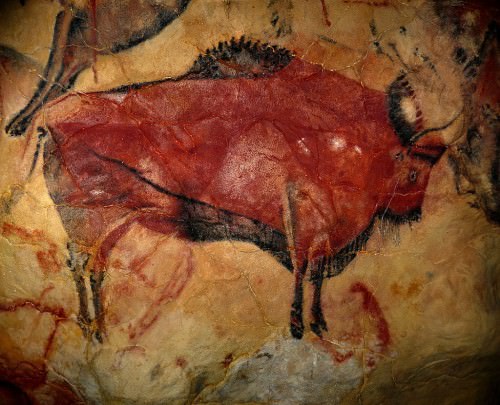
Cave Painting in the Altamira Cave
BOUNDARY MARKERS
Some scholars have claimed that rock art was produced as boundary markers by different communities during the time when climatic conditions increased the competition for territory between Upper Paleolithic hunter-gatherer communities. Cave art, according to this view, is seen as a sign of the ethnic or territorial divisions within the different Upper Paleolithic human groups coexisting in a given area. Cave art was used as a marker by hunting-gathering communities in order to indicate to other groups their 'right' to exploit a specific area and avoid potential conflicts. Michael Jochim and Clive Gamble have made very similar arguments: they proposed the idea that the Franco-Cantabrian region was a glacial refugium with such a high population density during the Upper Paleolithic that art was used as a social-cultural device to promote social cohesion in the face of the otherwise inevitable social conflict.
This argument is in line with demographic and social patterns during the Upper Paleolithic. More population density meant more competition and territorial awareness. However, this model has some flaws. Hatfield and Pittman note that this approach is not consistent with the stylistic unity displayed by some rock art traditions. David Whitley has observed that this argument is not only filled with a dose of 'western bias.' but it also contradicts the fact that no ethnographic study provides support for this claim. It could also be said that if Upper Paleolithic groups increased their awareness of territoriality, it is reasonable to expect some sort of indication of this in the archaeological record, such as an increase of signs of injuries inflicted with sharp or blunt weapons in human remains, or other signs of trauma that could be linked to inter-group conflicts. Although in this case it is possible that if the art actually helped to avoid conflict, no such signs would be detected.
STRUCTURALIST HYPOTHESIS
By analyzing the distribution of the images in different caves, André Leroi-Gourhan suggested that the distribution of the cave paintings is not random: he claimed there is a structure or pattern in its distribution, sometimes referred to as a 'blueprint'. Most horses and bison figures were, according to Leroi-Gourhan's studies, located in central sections of the caves and were also the most abundant animals, about 60% of the total. Leroi-Gourhan added that bisons represented female and horse male identity. He argued that some unchanging concepts relating to male and female identity were the basis of rock art. In the words of Paul Mellars:
Paleolithic art might be seen as reflecting some fundamental “binary opposition” in Upper Paleolithic society, structured (perhaps predictably) around the oppositions between male and female components of society (Mellars, in Cunliffe 2001: 72).
In addition to studying the figurative art, Leroi-Gourhan also paid attention to the abstract motifs and tried to explain them within the context of the structuralist thought that was dominant during his time in linguistics, literary criticism, cultural studies, and anthropology, especially in France. Sructuralist thought claims that human cultures are systems that can be analyzed in terms of the structural relations among their elements. Cultural systems contain universal patterns that are products of the invariant structure of the human mind: proof of this can be detected in the patterns displayed in mythology, art, religion, ritual, and other cultural traditions.
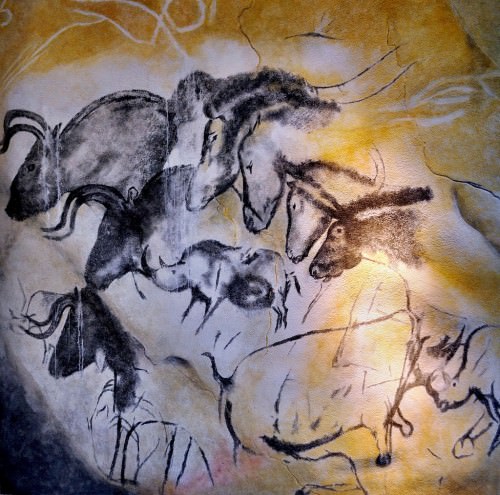
Cave Paintings in the Chauvet Cave
Initially, this explanation was very popular and widely accepted by scholars. However, when André Leroi-Gourhan attempted to fit the evidence into his standard layout scheme, a correlation could not be proven. It also became evident, as more rock art was discovered, that each site had a unique layout and it was not possible to apply a general scheme that would fit all of them.
Although unsuccessful, the approach of André Leroi-Gourhan was influential. He also has another important merit: at the time, structuralist thought was dominant in many academic disciplines: by attempting a structuralist explanation of rock art, Leroi-Gourhan was seeking to show that Upper Paleolithic people were not ignorant savages but were people with cognitive capacity, just like people today.
HUNTING MAGIC
Another suggestion is that Upper Paleolithic rock art is a manifestation of sympathetic magic, designed as an aid for hunting, in the words of Paul Mellars, to "secure control over particular species of animals which were crucially important human food supply". Some supporting evidence of this view includes the fact that sometimes the animals were apparently depicted with inflicted wounds, coupled with ethnographic analogy based on supposed similarities between Upper Paleolithic art and Australian Aboriginal rock art. Magic rituals may not have a direct material outcome, but this type of practice surely boosts the confidence and has a direct psychological benefit (a form of placebo effect), increasing the success of hunting activities. In this context, Upper Paleolithic rock art is seen as a tool to magically benefit the groups' subsistence, encouraging the success of the hunters.
The ethnographic data indicating that magic plays a significant role in tribal life does not only come from Australian Aboriginal groups. Other examples are found among the native Kiriwina people who live in Papua New Guinea, where the levels of superstition and magic ceremonies rise with the levels of uncertainty: when it comes to canoe building, for example, we read that magic
is used only in the case of the larger sea-going canoes. The small canoes, used on the calm lagoon or near the shore, where there is no danger, are quite ignored by the magician (Malinowski 1948: 166, emphasis added).
This emphasizes the idea that magic can be a psychological response to conditions where uncertainty grows, which is what we would expect in the case of hunters affected by increasing population pressure.
SHAMANISM
In this explanation, Upper Paleolithic art is the result of drug-inducing trance-like states of the artists. This is based on ethnographic data linked to San rock art in Southern Africa, which has some common elements with European Upper Paleolithic art.

San rock art
Lewis-Williams has argued that some of the abstract symbols are actually depictions of hallucinations and dreams. The San religious specialists, or Shamans, perform their religious functions under a drug-induced state: going into trance allows them to enter into the 'spirit realm', and it is during this states that shamans claim to see 'threads of lights' which are used to enter and exit the spirit realm. When the human brain enters into certain altered states, bright lines are part of the visual hallucinations experienced by the individuals: this pattern is not linked to the cultural background but rather a default response of the brain.Long, thin red lines interacting with other images are present in San rock paintings and are considered to be the 'threads of light' reported by the shamans, while the spirit realm is believed to be behind the rock walls: some of the lines and other images appear to enter or exit from cracks or steps in the rock walls, and the paintings are 'veils' between this world and the spirit world.
This is another solid argument. Nonetheless, there is no basis to generalize the idea of shamanism as the cause of European rock art as a whole. Shamanic practices could be, at best, considered a specific variation of the religious and magical traditions. Shamans do not create magic and religion; instead, it is the propensity for believing in magic and religion present in virtually every society that is the origin of shamans. Ultimately, this argument rests on magic and religious practices, not far from the argument that sees art as a form of hunting magic.
CONCLUSION
Since almost all cultural developments have multiple causes, it seems reasonable to suppose that the development of Upper Paleolithic has a multi-causal explanation rather than a single cause. None of the arguments presented above can account fully for the development of Upper Paleolithic rock art in Europe.
Anthropological studies worldwide commonly emphasize the religious/spiritual origin of rock art. This is not the only origin detected thorough ethnographic studies; there are examples of secular use, but it is apparently the most frequent. However, it could also be the case that art in the European Upper Paleolithic had a different meaning from the communities that ethnographers have been able to study. Archaeology has been able to detect caves that may have been connected to rituals and magic at least in some Upper Paleolithic communities of Europe. Human burials were found in the Cussac cave associated with Paleolithic art: according to some authors, this stresses the religious/spiritual character of the rock art found in some caves.
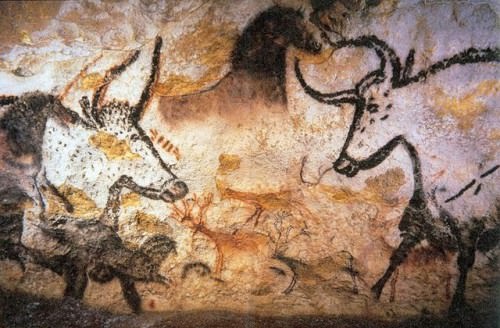
Cave Painting in Lascaux
If the assumption that at least some European rock was created for religious reasons can be accepted, then it is safe to suppose that rock art is just the most archaeologically visible evidence of prehistoric ritual and belief, and unless rock art was the only and exclusive material expression of the religious life of prehistoric communities, we can assume that there is an entire range of religious material that has not survived. Some of the Upper Paleolithic portable art could also be connected to religious aspects and be part of the 'material package' of prehistoric ritual.
Our knowledge on the meaning of Upper Paleolithic rock and portable art should not be considered either correct or incorrect, only fragmentary. The element of uncertainty, which involves the rejection of any form of dogmatic or simplistic explanation, is likely to always be present in this field of study. This should lead to flexible models complementing each other and the willingness to accept that, as more evidence is revealed, arguments will have to be adjusted.
LICENSE:
Article based on information obtained from these sources:with permission from the Website Ancient History Encyclopedia
Content is available under License Creative Commons: Attribution-NonCommercial-ShareAlike 3.0 Unported. CC-BY-NC-SA License